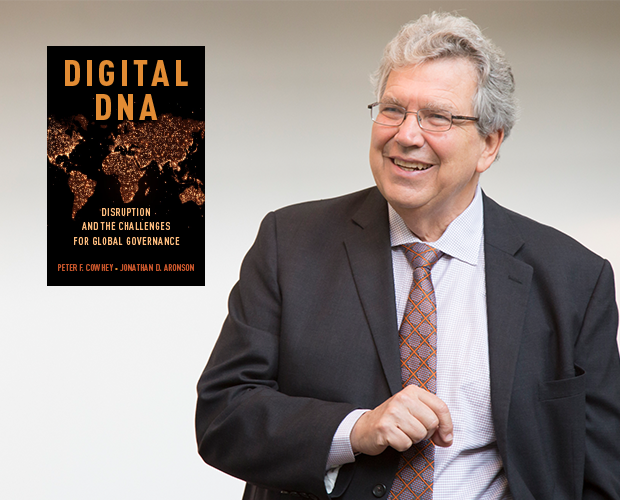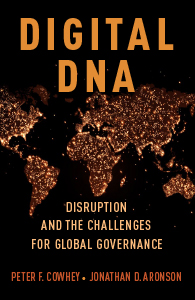Peter Cowhey and the 21st century digital economy

In a Q&A, Dean Peter Cowhey discusses the challenges and disruptions of the digital revolution in his new book “Digital DNA”
Oct. 20, 2017 | By Rachel Hommel | GPS News
As the former chief of the International Bureau of the Federal Communications Commission (FCC) and senior counselor to the U.S. Trade Representative, UC San Diego School of Global Policy and Strategy (GPS) Dean Peter F. Cowhey has negotiated many of the U.S. international agreements for telecommunications and digital technology services. From antitrust decisions to his expansive work in both the Clinton and Obama administration, he is an expert on the future of digital technology.
In his new book, “Digital DNA: Disruption and the Challenges for Global Governance,” Cowhey offers an in-depth examination of the digital technologies, or digital DNA, that that are transforming business models across all industries, including traditional manufacturing and agriculture.
What’s behind the name “Digital DNA?”
We chose the book title "Digital DNA” because it pithily stated our premise that digital technology is the fundamental DNA of the emerging world economy. Digital is not just important for computers or communications. It is becoming equally important for industries like agriculture and construction.
The book wrestles with the question what are the special attributes and policy problems created by spreading digital technology to all parts of our global economy and society.
Who should read this?
The book is published by an academic press so we hope one part of its readership are scholars in the field of international economic policy, domestic public policy, management strategy and government economic regulation tied to the digital industries.
The other part will be working professionals in the field. There are many people in government wrestling with these issues, there are numerous corporate executives thinking about these problems and we believe the book is clearly enough written with a minimum of academic jargon to engage them.
What do you hope is the real-world impact of this book?
“Digital DNA” is an analytic policy book – taking academic scholarship and applying it to enlighten our choices about governing digital technologies. It has to both be fair and succinct about what’s relevant from academic studies to solving this policy problem. It has to tell a story that people find convincing about changes occurring in the world economy today and their implications.
We chose to illustrate the policy challenges by looking at three hard problems created by digital technologies: what are the proper set of economic regulations and trade policies to govern the cloud computing infrastructure; how to manage challenges tied to cybersecurity; and what can we do in regards to the protection of digital privacy. We argue that issues of cybersecurity and digital privacy are intertwined, and you have to address them jointly in order to create a trusted digital environment.
Chapter 7 deals with the topic of cybersecurity. You’ve taught a cybersecurity course for years at the School? Can you talk a little about writing on a topic vs. teaching in the classroom?
The chapter illustrates both the teaching and analytic approach of the book. In my class, co-taught by computer science professor Stefan Savage, we walk students through a series of particular cases to illustrate how you can think about the analytic policy approach that might succeed. We don’t try to solve all the problems, but we show students how to think about them, where policy mistakes frequently arise, and the issues to address in designing solutions
What we are really doing is fundamentally tied to the GPS notion of the ‘toolbox’ – we are helping students create their toolbox, illustrating how to use the toolbox selectively, and then telling them in their group projects that they have to go out and try it on their own.
You’ve written alongside Aronson for some time now. In fact, since 1983. In your opinion, what makes you two a writing powerhouse?
There is some truth in saying that it’s good if you can write with your best friend because you won’t stay best friends for long if you don’t write well together. When I say we are best friends, I mean it…we were each other’s best man at our weddings.
We have different strengths in our writing relationship and have come to understand each other foibles along the way. Because we understand our division of labor, we don’t spend a lot of time worrying about the execution of co-authorship.
 So, what’s the next big project on your—or yours and Aronson’s—plate?
So, what’s the next big project on your—or yours and Aronson’s—plate?
This isn’t our first rodeo. In the mid 1980s, we wrote a book proposing a complete restructuring of trade and regulatory arrangements to govern global telecommunications and computer networks. When we first proposed it, it was considered outrageously radical – people were much more comfortable with our minimalist suggestions but we kept arguing that the maximum proposals were the right way to deal with what was going to be a large technological and economic revolution. Eventually, our vision became global policy.
This book proposes a revised approach, combining international trade policy on market access with national regulatory policies that govern cybersecurity and digital privacy. No one has quite come up with approach we suggested. While not all policy proposals have a happy ending, we know what you have to do to have the possibility of a happy ending.
How is the digital revolution changing the global economy? Where are we headed?
The most important thing to understand about this digital revolution is that it is no longer confined to white collar offices and research labs or consumer devices like your mobile phone. On average in the U.S. today, a manufactured product’s valued added may be 25 percent digital, including communication, software, data – a whole variety of digital inputs. This is transforming both the business models for even traditional technology and radically changing how we do the delivery of products.
When we think about the economy of the future, we have to understand that it is all going to be digitally informed, digital observed and digitally at risk. All of those things go together and, on balance, we will be better off. But public policies need to look out for public interest concerns.

